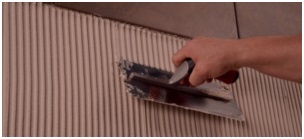Large format tiles are not a new concept, it has been around but presently it has shown growth in demand due to a variety of reasons. It is aesthetically pleasing and adheres to residential commercial applications quite easily. Large format tiles make space look larger and are available in every style of choice. A tile is considered large format if the length of one side is more than 400mm as per IS standard, ISO standard, ANSI standard, BS EN standard, etc., Tiles with thickness range between 3 to 5 mm are normally designated as Slim tiles and are available from small size to a large size of 4’ X 6’ also.
Large format / Slim tiles can be installed on the rigid substrate like plastered walls and on limited vibrating substrates like Plywood and metal. It is strongly recommended to install Large format / Slim tiles using an adhesive and not as a dry cladding system.
Some of the important points to keep in our checklist while installing Large format are:
Large Format Tile’s Substrate requirements

- The substrate to which large format / slim tiles are to be installed should be perfectly flat.
- Vibrating surfaces like plywood / metal should be rigid and strongly fastened to the structure to limit the vibration and deflection.
- Substrate tensile strength should be good enough to bare a dead load of tiles.
Large Format Tile’s Adhesive:

- Adhesive used for the installation of Large format / slim tiles should be of long open time to prevent drying / skinning before the tile is installed.
- Tensile strength / pull-off strength of adhesive must be tested at LAB as well as at site using the same Large format / slim tiles pieces.
- Adhesive shall be engineered in such a way that it can be applied at less thickness like 2mm and even at a higher thickness of 10-12mm.
- Adhesive should not allow installed tile to sag / slip from the position.
- Adhesive should not transform the upcoming cracks in the structure to the installed large format / Slim tiles.
- Overall, specification to which adhesive must confirm is EN 12004 and IS 15477: 2019.
Large Format Tile’s Adhesive Trowel:

- For the application of adhesive, use the “U” notch or “Square” notch trowel.
- Along with the application of adhesive on the substrate, it is advisable to use back buttering style for the installation of large format tiles.
- Make sure that the installed tile has obtained 100% adhesion with the adhesive rib pressed.
- During the installation of large format / large slim tiles, sufficient manpower should be planned with proper tools & tackles.
Gaps for movement accommodation of Large Format Tiles :
- Nothing is static in the world… Substrate and tile will tend to move due to many reasons and this movement should be accommodated.
- It is best practice to maintain the 2-3mm joint gap around the Large format / Slim tile.
- Movement joints shall be maintained at every 3 Mtr in grid size with a width of 3-5mm and fill it with sealant.
ARDEX ENDURA India manufactures a range of Tile Adhesives, Tile Joint Grouts, Tile Care Products like Tile Cleaner & tile/stone sealer and other building chemicals that are developed with technical support from ARDEX, Germany.
ARDIFLEX S1, best tile adhesive for large wall tiles. The adhesive contains fiber-reinforcement to impede crack mitigation from the substrate to the tile. EPOXY GROUT, tile joint grout is available in a range of 200+ colours to meet every colour requirement. The grout is stain proof, bacteria resistant and US FDA certified (safe for direct food contact).
For more details, visit- ardexendura.com/products/tile-and-stone-installations/

